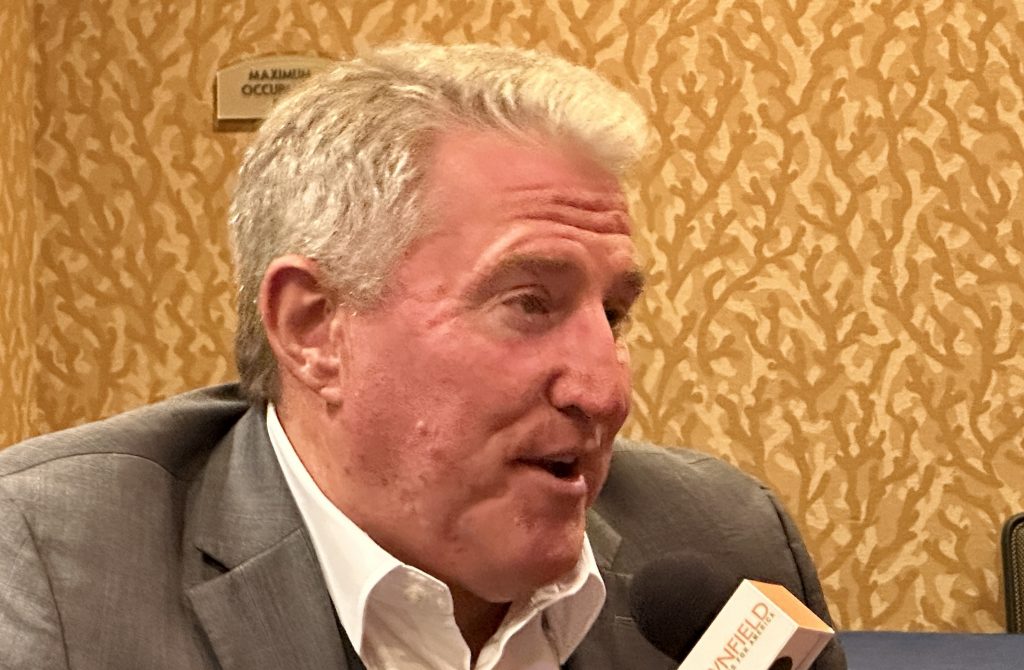
At the Cattle Industry Summer Business Meeting, California, Senior Farm and Ranch Broadcaster Ron Hays talked with the president and CEO of the United States Meat Export Federation, Dan Halstrom, about worldwide export markets.
Coverage from the 2024 Cattle Industry Summer Business Meeting in San Diego is being powered by Farm Data Services of Stillwater.
Halstrom said that despite multiple reasons not to be, May’s export numbers are relatively good. They show robust growth in Latin American countries, and even some rebound in Japan’s food service arena. “We are in a thirty-some year low of the yen against the dollar, which makes our products more expensive in yen terms. However, the positive of that is that tourism is booming, because the dollar is so strong in Japan.”
He said that Korea is down some following 2023’s record-setting numbers for Korean exports. “There are some adjustments going on there, but the real story in past six months has been in Mexico and some of the Latin American countries. Columbia is booming on beef and pork. If you combine what’s going on incrementally in Latin America, and overlay that with some of our traditional markets, it’s a pretty good story in light of lower production.”
The reason Halstrom believes that U.S. exports to Mexico are so strong in part because they are in a drought which puts pressure on their supply chain and raises their own prices. Also, their demand is at an all-time high. He said that while they are price conscious relative to Japan, their focus is shifting to supply and quality. He mentioned their recent presidential election and that the new administration appears to be trade-friendly.
Halstrom said that the key to weathering the years-long cycle of low production is to maximize on the whole carcass. “The end-cuts, rounds, chucks, and short-plates are strongholds, but there are only so many of these in an animal. We’ve been working a lot on the round, knuckles – inside, outside round flats. We’ve had a lot of success around the world incrementally with an item that they didn’t traditionally use.”
He went on to explain how smart global buyers are because they understand where the cycle currently is. They understand that there aren’t enough short cuts, but are willing for look at other cuts to replace them.
The key to building trust with the buyers so they are willing to accept alternate cuts is to have boots on the ground. “This is why we have folks in twenty regions around the world developing relationships each and every day. When you have a relationship with a buyer, be it a Sam’s Club or a Costco or an Aeon in Japan, they are reaching out as much as we are pushing saying, ‘Educate us. How do we use an outside round flat as a substitute for xyz cut?’ This is what our team is doing everyday. They are talking about the situation and what can be done to make the best of it.”
Halstrom anticipates when production normalizes and they still have all of the new cuts they have been using in their toolbox.
Looking forward into the latter part of the year, Halstrom expects pork to stay strong, and may get stronger, and despite higher beef prices, and relatively higher prices on pork, he believes the U.S. is still in a good position.
“People are buying a little bit hand-to-mouth,” he said. “When that happens, price isn’t the main concern; supply is. I think that is the situation we are in as we look at the last half of the year which is a good place for us to be.”
Worldwide consumers have proven willing to pay for quality. Halstrom said, “There is a reason that eighty-five plus percent of our product is grading choice and higher, because that is what the consumer wants. Mexico used to be primarily a select and lower market, but it’s now changing to a choice and higher market because they want the quality and consistency. We aren’t trying to market to everybody. We are trying to market to those demographics that appreciate and can afford our quality, and that’s what we are seeing in Mexico today.”
The Beef Buzz is a regular feature heard on radio stations around the region on the Radio Oklahoma Ag Network and is a regular audio feature found on this website as well. Click on the LISTEN BAR at the top of the story for today’s show and check out our archives for older Beef Buzz shows covering the gamut of the beef cattle industry today.


















